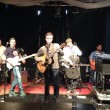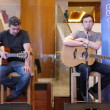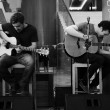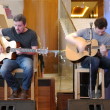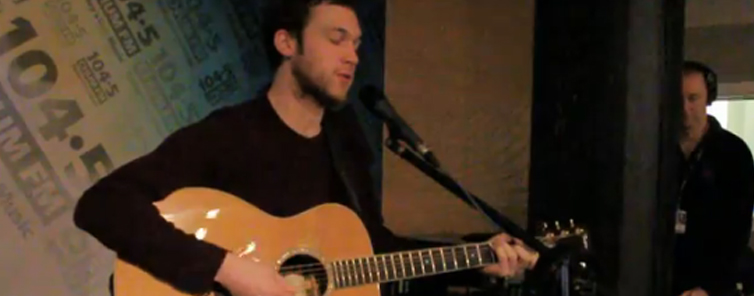One of the best things about being a music fan is making discoveries, the way listening to one band leads you to discover another one, and admiring one musician leads you to love another one. So is the case with Phillip Phillips fans, who in the last couple of years have been lucky to be introduced to Errol Cooney, a guitarist and music scene veteran who has quickly become synonymous with Phillips’ wildly diverse sound. From rock, to soul, to jazz and funk, Cooney has done it all, having played small and big stages with artists such as Lalah Hathaway, Christina Aguilera and music giant Stevie Wonder.
As Phillips’ lead guitarist and acoustic guitar duo partner, Cooney brings an incredible range of influences that help him create soulful melodic landscapes around Phillips’ intricate playing and writing. Phillips and Cooney’s collaboration was captured last year in the iTunes Session (a beautiful and raw acoustic album) and more recently on Phillips’ second album, Behind The Light.
Errol Cooney took a few minutes out of his busy touring schedule recently to answer some questions exclusively for PhillPhillcom. Read on to learn about his wide-ranging musical influences, his collaboration with Phillips on Behind The Light, and the one word that may help explain his very cool and chill vibe.
PhillPhillcom: How old were you when you started playing?
Errol Cooney: 12.
PhillPhillcom: Did you always know you wanted to play the guitar? Were your parents supportive of your musical ambitions?
EC: I got interested when I was around 8 or 9 when I saw both of my older brothers, Michael and Brian playing and singing. My parents were very supportive. They are both very creative in their careers; my father is an actor and singer, my mother an actress, singer, pianist and writer.
PhillPhillcom: Who were you major influences or inspiration when you were starting out?
EC: At first classic rock; The Beatles, Led Zeppelin, Pink Floyd, James Taylor, Stevie Ray Vaughn, The Eagles and Jimi Hendrix. I’ve gotten into all sorts of things since-heavier stuff like Ministry and Sepultura, then Parliament-Funkadelic, Steely Dan, James Brown, Miles Davis, Herbie Hancock, Wes Montgomery, Joe Pass, John Coltrane, Thelonious Monk and a million others as I got older. This list could go on forever!
PhillPhillcom: You have performed with some big names in music, including the legendary Stevie Wonder. What was your first big, “I made it” show and was it what you expected it to be?
EC: I don’t think you ever necessarily “make it” but getting to do the Stevie Wonder gig has been pretty special to me. I’ve idolized him since I was very young. The first major tour I did was opening for R. Kelly with a singer named Sunshine Anderson. That was a lot of fun. I don’t believe you can ever stop growing as a musician and become complacent. If you do, it’s time to do something else.
PhillPhillcom: You have also recorded with many other musicians in the studio. Do you consider yourself to be more of a live guitar player or a studio musician? Do you prefer one more than the other?
EC: I’ve been lucky enough to do a lot of both and I love doing both. They are amazingly different, especially as recording technology has changed so much over the years. There’s nothing like the rush and energy of playing live with a group of musicians for people that are there sharing that energy with you. And there’s nothing like creating music in the studio with artists, producers and musicians that you hope will stand the test of time. You get to dig through it with a fine-toothed comb and be spontaneous at the same time.
PhillPhillcom: In the last couple of years you have become well known to Phillip Phillips fans as his guitar duo partner and lead guitar player on his band. How did you come to work with Phillip?
EC: I have worked with American Idol as a hired musician for many years. Particularly in the house band for the tour Phillip was on. We started doing radio shows together as a duo at the time and hit it off. We have a good time playing along with the rest of the group. He’s a special talent.
PhillPhillcom: How is it going from a very large band setting (such as when you perform with Stevie Wonder), to essentially a rock band setting as you have in Phillip’s band?
EC: It’s a lot of fun. I love the rawness of Phillip’s project.
PhillPhillcom: The iTunes Session, which you recorded with Phillip last year, is a fans’ favourite; it captures your collaboration with Phillip really well. How was it recording that?
EC: A lot of fun. Very spontaneous. We went in there for a very short amount of time and came out with something I think we are both proud of.
PhillPhillcom: You also got to play on Phillip’s new album Behind The Light. There are so many beautiful guitar moments on this album. Do you have any particular songs from Behind The Light that you loved working on?
EC: “Face” was really cool. I love the writing he did and it’s very minimal live arrangement. There were lots of others I enjoyed a lot- “Fly,” “Trigger,” “Raging Fire” to name a few.
PhillPhillcom: You are setting up to go on tour with Phillip very soon. What are some of your favourite cities or venues to play in?
EC: Vancouver tonight! Austin, Rio, Quebec City, Red Rocks in Colorado, Bay Area, Paris, Amsterdam, I love everywhere I go!!
PhillPhillcom: You have played hundreds of shows through your career, both with Phillip and many other musicians. Do you have any really memorable or favourite performance from past tours?
EC: River Plate stadium in Buenos Aires, Paris with Stevie Wonder, Glastonbury Festival, Bonnaroo, Red Rocks with Phillip, the White House, A Capitol Fourth.
PhillPhillcom: What band or musicians are you into right now that you can’t stop listening to on your iPod?
EC: Radiohead right now as I write this.
PhillPhillcom: The world is ending, you have to save three albums that, if you survive, you will have to live with for the rest of your life. Which ones do you take with you?
EC: Axis: Bold as Love-Jimi Hendrix, Songs in the Key of Life-Stevie Wonder, Abbey Road-The Beatles.
PhillPhillcom: Finally, Errol Cooney in one word:
EC: Sleepy.



















